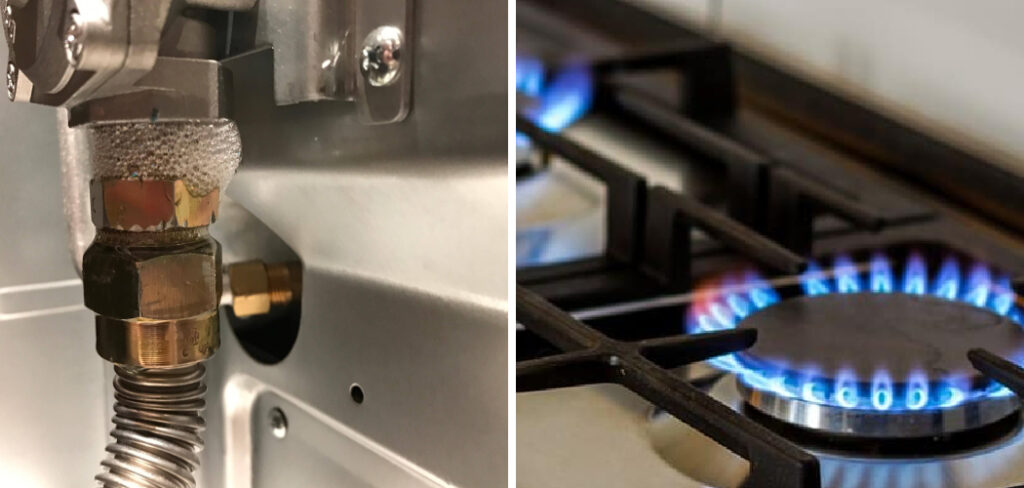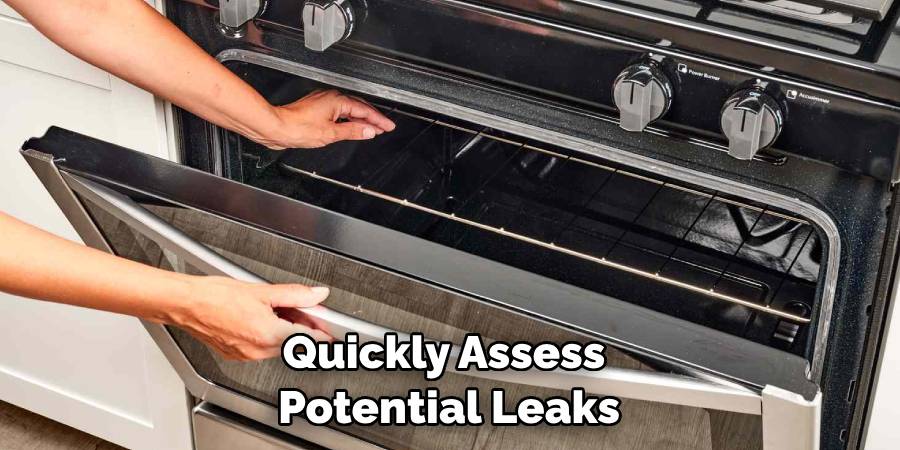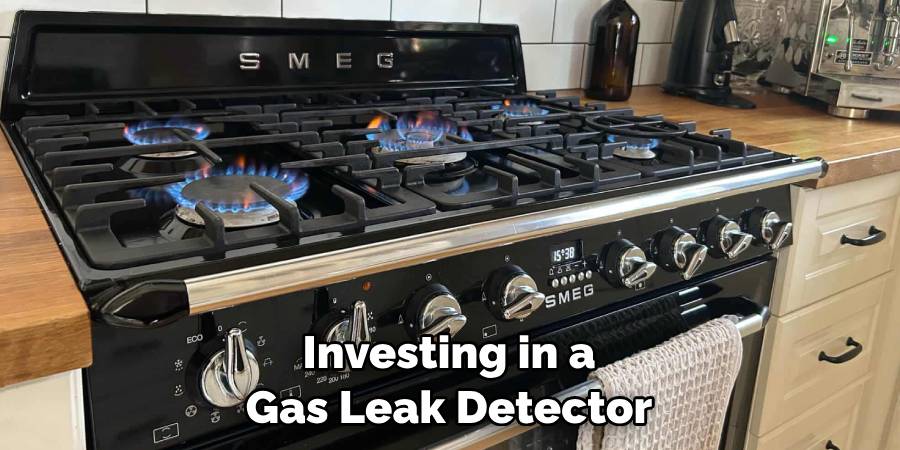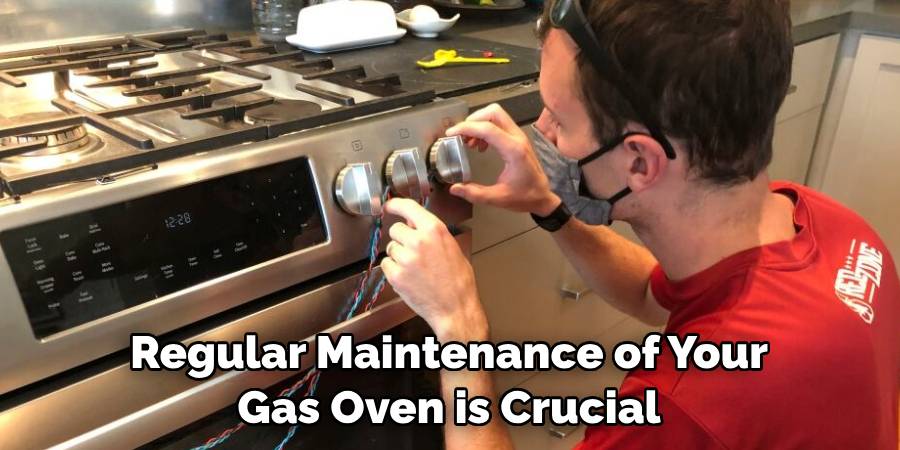Are you worried that your gas oven may be leaking? It’s important to check for any signs of a gas leak regularly, as this can pose serious safety hazards.

Gas ovens are a standard appliance in many kitchens, offering an efficient way to cook meals. However, safety concerns arise when there is a potential gas leak, which can pose serious risks, including fires and health hazards. Understanding how to identify signs of a gas leak is crucial for every homeowner.
In this guide, we’ll explore how to tell if gas oven is leaking, the steps you should take to confirm your suspicions and the necessary actions to ensure your home remains safe and secure. Recognizing these early warning signs can help you address potential issues before they escalate, protecting your family and property.
What Will You Need?
Before we dive into identifying gas leaks, it’s essential to gather all the necessary equipment. Here are a few items you’ll need:
- A gas leak detector
- Soapy water in a spray bottle
- Clean cloth or towel
- Protective gloves and goggles (optional)
Having these tools on hand will help you accurately detect and address any potential gas leaks.
10 Easy Steps on How to Tell if Gas Oven is Leaking
Step 1. Conduct a Visual Inspection
Begin by visually inspecting your gas oven. Look for wear, tear, or damage around the gas lines and connections. Check for any bent or broken hoses, which could indicate a potential leak.
Additionally, ensure that all knobs and dials are in their correct positions and that there are no obstructions or foreign objects near the gas supply.
Step 2. Perform a Soapy Water Test
Once you’ve completed the visual inspection, it’s time to perform the soapy water test.
Mix mild dish soap with water and pour or spray the solution onto the gas line connections, hoses, and other suspect areas.
Observe any bubbles that form; if you see bubbles growing or hissing sounds, it strongly indicates the gas is leaking. This simple yet effective method can quickly assess potential leaks in your gas oven.

Step 3. Listen for Hissing Sounds
Another critical step in identifying a gas leak is to listen carefully for any hissing sounds coming from your gas oven.
These sounds may indicate escaping gas. Turn off any other appliances or distractions to ensure you can hear clearly. If you hear a hissing noise, it’s crucial to take immediate action, as this could signify a significant leak requiring urgent attention.
Step 4. Check for Gas Odour
A distinct smell similar to rotten eggs is often a telling sign of a gas leak, as utilities typically add an odorant called mercaptan to natural gas for easy detection.
When checking for gas odor, performing this step in a well-ventilated area is essential. If you notice any unusual odor while standing near the gas oven, refrain from igniting flames or turning on electrical appliances, as this could trigger a fire or explosion.
Instead, exit the premises immediately and contact your gas supplier or a qualified technician to assess the situation. Remember, it’s better to err on caution—if you suspect a gas leak, take immediate action rather than risk your safety.
Step 5. Monitor Your Gas Bill
Keeping an eye on your gas bill can reveal significant insights into your gas usage patterns and help you identify potential leaks. If you notice an unexplained increase in your gas bill without any corresponding change in your cooking habits or usage levels, this could be a sign that your gas oven is leaking.
A sudden spike in costs often indicates that gas is escaping from somewhere, leading to higher consumption. To maintain accurate records, compare your gas bills over a few months to see if a pattern emerges. If you suspect a gas leak based on these discrepancies, take action and return to the previous steps to confirm your suspicions.
Addressing unusual charges promptly can save you money and prevent potential hazards related to gas leaks.
Consistent tracking of your gas consumption not only aids in leak detection but also promotes a more efficient and economical use of energy resources in your home.
Step 6. Use a Gas Leak Detector
Investing in a gas leak detector is a proactive measure to ensure your safety. These devices can be placed around your kitchen and are designed to provide immediate alerts when they detect the presence of gas. Make sure to follow the manufacturer’s instructions for installation and regular maintenance.

Place detectors near the stove and gas lines for optimal coverage. Remember that although these detectors are helpful, they should not replace your other detection methods; use them with visual inspections and soapy water tests for comprehensive safety checks.
If your detector alerts you to a gas presence, evacuate the area without delay and seek professional assistance to address the issue.
Step 7. Check the Pressure Regulator
The pressure regulator is a crucial component in your gas oven that controls gas flow and ensures safe operation. To check the regulator, first, locate it near the gas inlet.
Inspect it for any signs of damage or leaks, and ensure it is properly connected. If you suspect issues with the pressure regulator, it may produce irregular flames or inconsistent heating during cooking.
In such cases, it’s advisable to consult a qualified technician to assess the regulator’s functionality and make necessary adjustments or replacements to ensure your gas oven operates safely and efficiently.
Step 8. Examine Flame Colour
The color of the flames in your gas oven can provide essential clues regarding its operation.
Ideally, the fire should appear blue with a steady, even burn. If you notice any yellow, orange, or red tips on the fire, it could indicate incomplete combustion, which may suggest a leak or a malfunction.
In such cases, it’s essential to address the issue by turning off the oven and contacting a qualified technician to investigate the problem. Observing flame color regularly can help ensure your gas oven is functioning safely and efficiently.
Step 9. Inspect Ventilation
Proper ventilation is essential when using gas appliances.
Ensure that the area around your gas oven is well-ventilated to mitigate the build-up of gas should a leak occur. Check that vents and ducts are unobstructed and functioning correctly.
Additionally, having a carbon monoxide detector installed in your home provides extra safety, as it can alert you to carbon monoxide levels that might increase due to incomplete combustion resulting from a gas leak.
Step 10. Schedule Regular Maintenance
Finally, regular maintenance of your gas oven is crucial for optimal performance and safety.
Schedule professional inspections at least once a year, where a technician can thoroughly check for leaks, assess the condition of the gas lines, and ensure that all components are functioning correctly.

Routine maintenance not only extends the lifespan of your gas oven but also provides peace of mind, knowing that potential hazards are being addressed promptly.
By following these steps, you can ensure your gas oven’s safe and efficient operation. Remember always to prioritize safety and take immediate action if you suspect a gas leak.
5 Things You Should Avoid
1. Ignoring Signs of Unusual Odours: If you detect any strange smells near your gas oven, do not dismiss them as minor concerns. Even faint odors can indicate a potential leak that requires immediate attention. Always take such smells seriously and follow the proper safety protocols.
2. Delaying Repairs: If you suspect a gas leak or notice irregularities in your oven’s operation, do not wait to consult a technician. Delaying repairs can lead to increased risk and potential hazards. Addressing issues promptly helps ensure your safety and prevents further complications.
3. Overlooking Routine Maintenance: Neglecting regular maintenance checks can lead to undetected issues, including gas leaks. Avoid skipping scheduled inspections or ignoring minor problems that could escalate over time; proactive maintenance is crucial for safety.
4. Using Electrical Appliances Near the Oven: If you suspect a leak, avoid using electronic devices or turning on switches near your gas oven. Electrical sparks can ignite gas, creating dangerous situations. Always ensure the area is safe before using electrical appliances.
5. Relying Solely on Visual Checks: While visual inspections are essential to leak detection, more than relying on them alone is required. Avoid dismissing gas detectors or other safety measures; they provide crucial alerts and enhance your ability to detect leaks effectively.

By following these tips and avoiding common mistakes, you can ensure your gas oven’s safe and efficient operation.
Conclusion
In summary, how to tell if gas oven is leaking requires vigilance and proactive measures.
To ensure safe operation, regularly inspect for unusual smells, monitor flame colour, and check your pressure regulator.
Utilizing gas leak detectors and maintaining proper ventilation further enhance your safety. Additionally, scheduling routine maintenance checks with a qualified technician allows for the timely identification of potential issues.
By following these guidelines and promptly addressing any concerns, you can significantly mitigate risks associated with gas leaks and ensure the safe usage of your gas oven.
Always prioritise safety and don’t hesitate to seek professional help when needed.
Professional Focus
Angela Ervin, a former interior designer turned blogger, specializes in kitchen design and renovations. Through her website, she blends her passion for cooking with design expertise, sharing practical and creative ideas. Known for balancing functionality and beauty, Angela’s insightful content has made her a trusted voice in home design and lifestyle.
About the Author
Angela Ervin, an experienced interior designer and blogger, combines her passion for kitchen renovations with storytelling. Living in Petersburg with her family, she enjoys cooking and testing her projects firsthand. Known for her humor and relatable style, Angela shares creative, functional design insights through her content, making her a trusted voice in home design.
Education History
University: Virginia Commonwealth University
Degree: Bachelor of Fine Arts (BFA) in Interior Design
- Angela’s education at VCU focused on mastering core interior design principles, including spatial planning, color theory, materials selection, and sustainable design practices.
- She gained hands-on experience through studio projects and collaborative design exercises, which honed her ability to create functional and aesthetically pleasing environments.
- Her coursework also emphasized problem-solving and practical applications of design, preparing her for real-world projects like her self-directed kitchen renovations.
- The program’s strong foundation in both technical skills and creative expression shaped Angela’s ability to seamlessly integrate form and function in her work.


